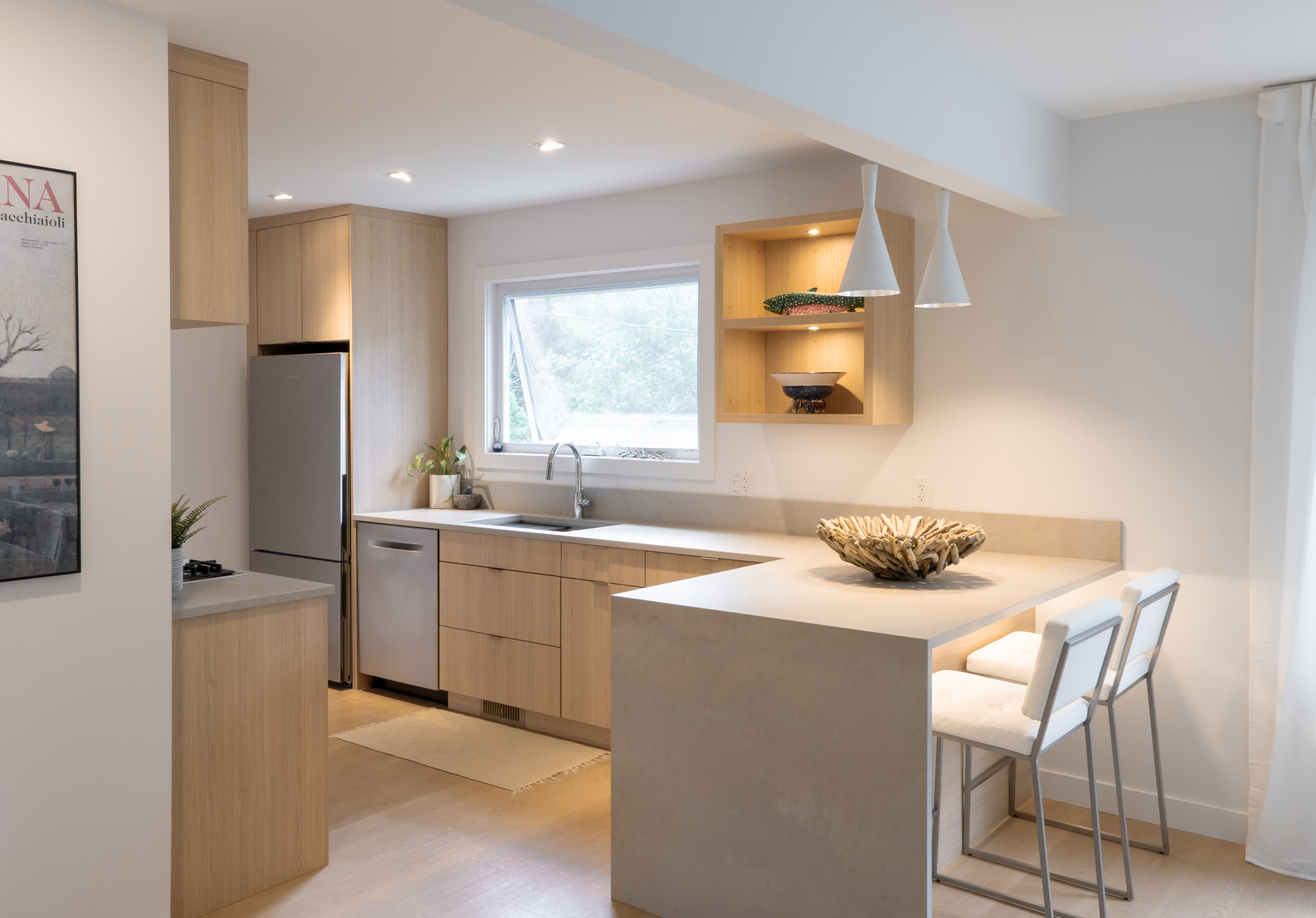Minimalist Kitchen Design Ideas for a Sleek Modern Look in recent years, the minimalist design trend has taken the world by storm, influencing everything from architecture and fashion to interior decor. Nowhere is this trend more impactful than in the heart of the home – the kitchen. Minimalist kitchen design is all about creating a clean, uncluttered, and functional space that balances form and function with an emphasis on simplicity and elegance. Whether you’re renovating your existing kitchen or starting from scratch, these ideas will help you achieve a sleek, modern look that’s both practical and stylish.

Understanding the Essence of Minimalist Kitchen Design
Before diving into the specifics, it’s essential to understand the core principles of minimalist kitchen design. At its heart, minimalism is about stripping away the unnecessary and focusing on what truly matters. This means eliminating visual clutter, maximizing functionality, and choosing high-quality materials that stand the test of time. It’s about creating a space that feels calm, organized, and purposeful.
1. Embrace the Power of Simplicity
The foundation of minimalist kitchen design lies in simplicity. This means choosing streamlined cabinets, clean lines, and understated finishes that contribute to a cohesive, clutter-free aesthetic. Opt for handleless cabinets or those with discreet, integrated pulls to maintain a seamless appearance.
For example, flat-panel cabinets in matte or high-gloss finishes can create a sleek, sophisticated look. Colors like crisp white, soft gray, or deep charcoal are excellent choices, as they promote a sense of calm and timeless elegance. For a more dramatic effect, consider pairing these tones with contrasting black or rich wood accents.
2. Optimize Layout for Functionality
A key element of minimalist kitchen design is creating a highly functional workspace. This often means embracing the classic kitchen work triangle – the efficient arrangement of the sink, stove, and refrigerator – to streamline meal prep and cleanup. However, modern minimalist kitchens also prioritize open layouts that promote flow and connectivity with adjacent living spaces.
Consider integrating a kitchen island or breakfast bar to provide additional workspace and seating without disrupting the clean lines of your design. Islands can also double as storage units, reducing the need for upper cabinets and keeping countertops clutter-free.
3. Prioritize Quality Over Quantity
Minimalism is about doing more with less, which means investing in fewer, higher-quality items that offer both functionality and aesthetic appeal. Choose durable, easy-to-clean materials like quartz, stainless steel, or polished concrete for countertops and backsplashes. These materials not only provide a sleek, modern look but also stand up to the demands of daily cooking.
Appliances should also reflect the minimalist ethos – think sleek, built-in ovens, induction cooktops, and hidden ventilation systems that blend seamlessly into your design. Opt for energy-efficient models to reduce your carbon footprint and enhance the long-term sustainability of your kitchen.
4. Declutter and Conceal
One of the defining characteristics of minimalist kitchen design is its emphasis on clutter-free spaces. This means finding creative ways to hide everyday kitchen essentials like small appliances, cookware, and utensils.
Consider installing deep drawers, pull-out pantry shelves, and custom cabinetry that can conceal items when not in use. Integrated storage solutions, like toe-kick drawers or appliance garages, are excellent for maintaining a sleek, uninterrupted appearance.
For a truly minimalist look, consider eliminating upper cabinets altogether, opting for open shelving or simple floating shelves that showcase only the most beautiful, functional items.
5. Use a Neutral Color Palette
Minimalist design typically relies on a neutral color palette that promotes a sense of calm and openness. Whites, grays, and muted earth tones are popular choices, as they create a clean, airy atmosphere that complements the streamlined aesthetics of minimalist kitchen design.
However, that doesn’t mean you have to sacrifice personality. Consider adding subtle pops of color through natural elements like wood grain, stone veining, or live plants. Metallic accents, like brushed brass faucets or matte black cabinet pulls, can also add a touch of sophistication without disrupting the minimalist vibe.
6. Focus on Smart Storage Solutions
Storage is crucial in any kitchen, but it’s especially important in a minimalist design where clutter is the enemy. Invest in clever, space-saving storage solutions that keep your kitchen organized and visually clean.
Pull-out shelves, deep drawers, and custom cabinet inserts can make the most of every inch of available space, ensuring that everything has a designated place. Consider adding built-in spice racks, drawer dividers, and corner cabinet solutions to eliminate wasted space.
7. Integrate Technology for a Modern Touch
Minimalism isn’t just about aesthetics – it’s also about efficiency. Integrating smart technology into your kitchen can enhance convenience while maintaining the clean lines of your design.
Smart appliances, like voice-activated faucets, Wi-Fi-enabled ovens, and integrated lighting systems, can streamline daily tasks and reduce the need for countertop clutter. For example, a smart refrigerator with a built-in touchscreen can eliminate the need for a messy family bulletin board, keeping your kitchen sleek and organized.
8. Choose Thoughtful Lighting
Lighting plays a crucial role in minimalist kitchen design, helping to define the space and highlight key architectural features. Opt for recessed ceiling lights, under-cabinet LED strips, or minimalist pendant lights to create a warm, inviting atmosphere without overwhelming the space.
Consider installing dimmer switches or smart lighting systems that allow you to adjust the brightness and color temperature based on the time of day or your specific needs.
9. Incorporate Natural Elements
While minimalism often focuses on clean, industrial aesthetics, incorporating natural materials can add warmth and texture to your kitchen. Wood, stone, and concrete can provide subtle contrast to sleek, modern surfaces, creating a more inviting, livable space.
For example, a solid wood countertop, marble backsplash, or concrete floor can add a tactile element that balances the cool, clean lines of minimalist kitchen design.
10. Personalize with Purpose
Finally, remember that minimalism doesn’t mean sacrificing personality. Personal touches, like a carefully curated collection of ceramics, a single piece of statement art, or a few well-chosen cookbooks, can add character without cluttering the space.




More Stories
Villa House Design Ideas That Feel Like a Getaway
Futuristic House Design Concepts That Wow
Traditional House Design Ideas That Stand the Test of Time